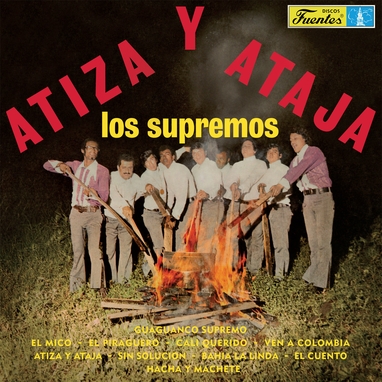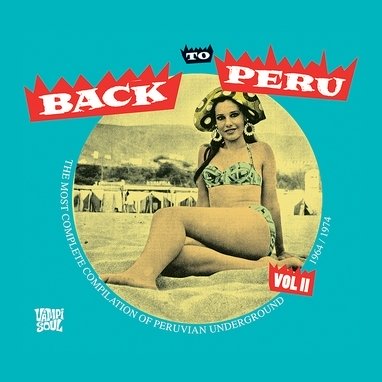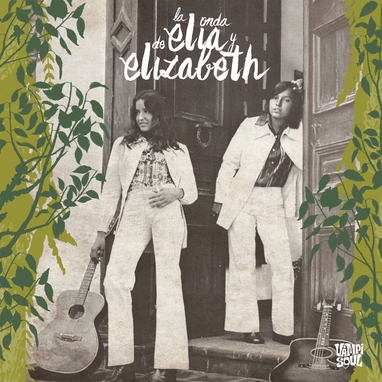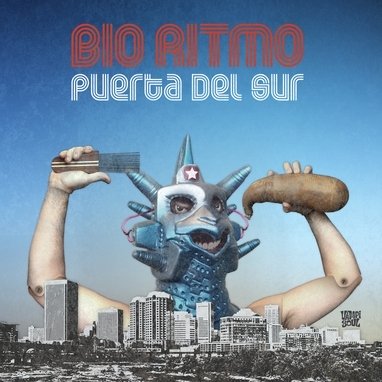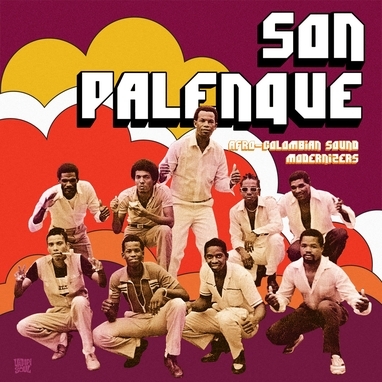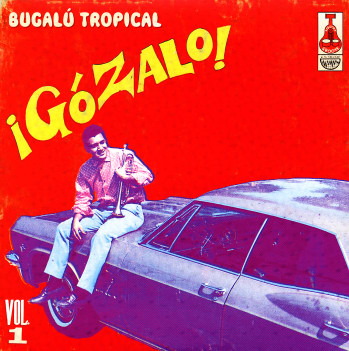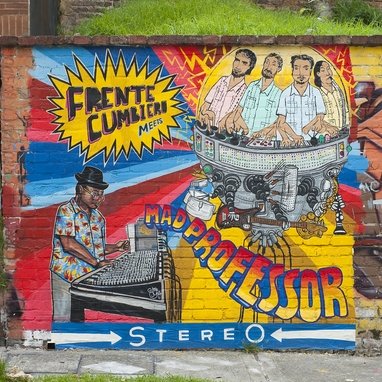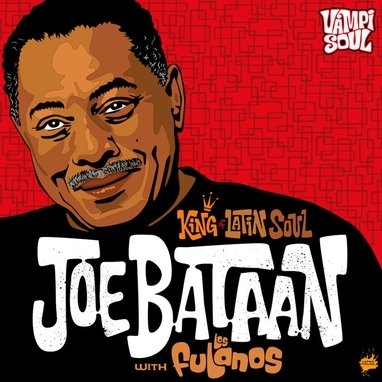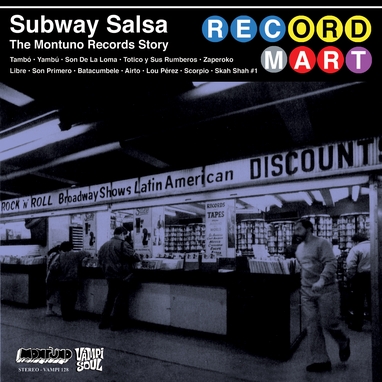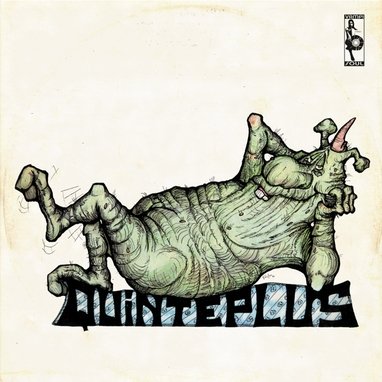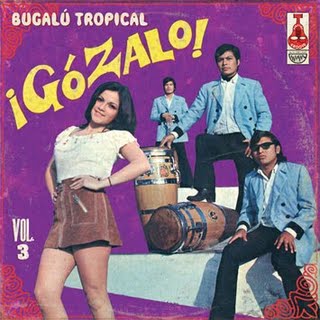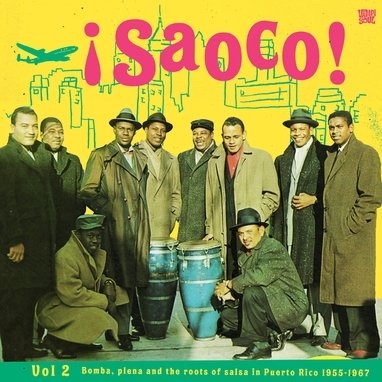Los Supremos
Atiza y ataja
16,00€
Vampisoul
Los Supremos
Atiza y ataja
The only album released by Los Supremos, Atiza y ataja (1971) was the debut recording for Edulfamid Molina Díaz, aka Piper Pimienta, who would soon make his mark as Fruko’s lead singer and later with The Latin Brothers and his own orchestra.
Grounded firmly in the Cuban style of La Sonora Matancera, with a prominent piano and crisp trumpet sound augmented by an additional double sax section, Los Supremos were also influenced by the NYC salsa dura and bugalú of Willie Colón, while managing to include coastal Colombian tropical music like cumbia and currulao, throwing in some improvised descarga jamming as well, making for a varied and hard-edged mix for one of Discos Fuentes’ first, and finest, forays into making salsa records.
Presented in facsimile artwork and pressed on 180g vinyl.
Discos Fuentes featured many great vocalists and composers in the realm of Colombian tropical music during the golden era of the 1960s and 1970s. One of the most talented and perhaps tragic figures of the 1970s salsa and cumbia boom in Colombia associated with Fuentes was Edulfamid Molina Díaz, aka Piper Pimienta, whose life was ended by a bullet from an anonymous assassin in 1998. Born in the town of Puerto Tejada, Cauca in 1939, El Showman de la Salsa was raised in the barrio of Obrero, Cali, and was distinguished from an early age by his thin stature, sharp sense of style, strikingly wide-ranging voice and fiery dance moves. After several years singing and dancing with smaller bands in Cali, in 1965 Piper joined El Combo Swing, which then became the house band of the Monterrey nightclub in the port city of Buenaventura in 1968. Led by saxophonist José Duval Osorio with the principal composer being the pianist Luis Zúñiga El Chiqui, the re-named octet El Combo Monterrey were fronted by the dynamic vocal duo of Piper Pimienta and Pedro Botina Guevara, aka Peter Scoot. Several members went on to become important sidemen in the bands Grupo Niche and Orquesta Guayacán, but it was Piper Pimienta, making his recording debut here, who would go on to the most fame through his association with Discos Fuentes and Julio Ernesto Estrada, aka Fruko. After coming to the attention of producer José María Fuentes in Medellín in 1970, the band was boastfully renamed El Gran Combo Los Supremos and signed for a one album deal, recording Atiza y ataja (Push and Pull) in April of 1971. Grounded firmly in the Cuban style of La Sonora Matancera, with a prominent piano and crisp trumpet sound augmented by an additional double sax, Los Supremos were also influenced by the NYC salsa dura and bugalú of Willie Colón, while also managing to include coastal Colombian tropical music like cumbia and currulao, throwing in some improvised descarga jamming as well, making for a varied and hard-edged mix for one of Discos Fuentes’ first, and finest, forays into making salsa records. Atiza y ataja features 10 hard-hitting numbers and has long been a much sought-after collector’s item. The frenetically paced title opener is a largely improvised descarga guaguancó (jam session in the guaguancó rhythm). It became the biggest hit on the record, and no doubt helped to propel Piper Pimienta’s career and get him hired to sing lead with Fruko’s bands, Los Tesos and later The Latin Brothers, where the two would form a hit-making relationship that would write one of the most brilliant chapters in the history of Colombian tropical music. The next tunes, a paseaíto (short and fast paseo, akin to a cumbia) and a cumbia proper, were sung by Scoot and have that folkloric lyrical subject matter typical of the time. These are followed by ‘El mico’ (‘The Monkey’), a great example of Colombian salsa dura inspired by what was happening in New York and Puerto Rico at the time. The side closes out with another bouncy cumbia with Scoot on lead vocals and featuring the growling and whinnying equine trumpet of Don Fabio Espinosa. Side two kicks off with the most obvious homage to what was happening at Fania Records in New York City with the cumbelé titled ‘Hacha y machete’. Next up is the funky Cuban-style guajira (mixed with son montuno) ‘Sin solución’, with vocals shared by Pimienta and Scoot, bringing the Sonora Matancera influence to the fore. That’s followed by ‘Guaguancó supremo’ in an upbeat descarga style, a party jam that was also popular in the dance halls and radio airwaves of Cali and Buenaventura. Probably most interesting on the record is the subsequent track, ‘Bahía La Linda’, because unless you are familiar with Pacific region Afro-Colombian musical genres, chances are you don’t know what a currulao is and are not expecting to hear it in a mostly salsa-oriented album. Piper, who was from the region where the currulao is played and danced, sings it with gusto and also name-checks Marcos Markkitos Micolta, the singer for Buenaventura’s Peregoyo y su Combo Vacaná, a group that pioneered the eclectic approach to recording albums with many diverse genres and styles. The record ends with what is perhaps the most experimental tune in the whole repertoire, mixing funky Latin soul/boogaloo with guaguancó, the whole thing punctuated with sleigh bells and a sort of garage rock Northern soul vibe that ends Atiza y ataja on an appropriately festive note. DJ Bongohead (Peace & Rhythm)
Productos relacionados
16,00€
The only album released by Los Supremos, Atiza y ataja (1971) was the debut recording for Edulfamid Molina Díaz, aka Piper Pimienta, who would soon make his mark as Fruko’s lead singer and later with The Latin Brothers and his own orchestra.
Grounded firmly in the Cuban style of La Sonora Matancera, with a prominent piano and crisp trumpet sound augmented by an additional double sax section, Los Supremos were also influenced by the NYC salsa dura and bugalú of Willie Colón, while managing to include coastal Colombian tropical music like cumbia and currulao, throwing in some improvised descarga jamming as well, making for a varied and hard-edged mix for one of Discos Fuentes’ first, and finest, forays into making salsa records.
Presented in facsimile artwork and pressed on 180g vinyl.
Discos Fuentes featured many great vocalists and composers in the realm of Colombian tropical music during the golden era of the 1960s and 1970s. One of the most talented and perhaps tragic figures of the 1970s salsa and cumbia boom in Colombia associated with Fuentes was Edulfamid Molina Díaz, aka Piper Pimienta, whose life was ended by a bullet from an anonymous assassin in 1998. Born in the town of Puerto Tejada, Cauca in 1939, El Showman de la Salsa was raised in the barrio of Obrero, Cali, and was distinguished from an early age by his thin stature, sharp sense of style, strikingly wide-ranging voice and fiery dance moves. After several years singing and dancing with smaller bands in Cali, in 1965 Piper joined El Combo Swing, which then became the house band of the Monterrey nightclub in the port city of Buenaventura in 1968. Led by saxophonist José Duval Osorio with the principal composer being the pianist Luis Zúñiga El Chiqui, the re-named octet El Combo Monterrey were fronted by the dynamic vocal duo of Piper Pimienta and Pedro Botina Guevara, aka Peter Scoot. Several members went on to become important sidemen in the bands Grupo Niche and Orquesta Guayacán, but it was Piper Pimienta, making his recording debut here, who would go on to the most fame through his association with Discos Fuentes and Julio Ernesto Estrada, aka Fruko. After coming to the attention of producer José María Fuentes in Medellín in 1970, the band was boastfully renamed El Gran Combo Los Supremos and signed for a one album deal, recording Atiza y ataja (Push and Pull) in April of 1971. Grounded firmly in the Cuban style of La Sonora Matancera, with a prominent piano and crisp trumpet sound augmented by an additional double sax, Los Supremos were also influenced by the NYC salsa dura and bugalú of Willie Colón, while also managing to include coastal Colombian tropical music like cumbia and currulao, throwing in some improvised descarga jamming as well, making for a varied and hard-edged mix for one of Discos Fuentes’ first, and finest, forays into making salsa records. Atiza y ataja features 10 hard-hitting numbers and has long been a much sought-after collector’s item. The frenetically paced title opener is a largely improvised descarga guaguancó (jam session in the guaguancó rhythm). It became the biggest hit on the record, and no doubt helped to propel Piper Pimienta’s career and get him hired to sing lead with Fruko’s bands, Los Tesos and later The Latin Brothers, where the two would form a hit-making relationship that would write one of the most brilliant chapters in the history of Colombian tropical music. The next tunes, a paseaíto (short and fast paseo, akin to a cumbia) and a cumbia proper, were sung by Scoot and have that folkloric lyrical subject matter typical of the time. These are followed by ‘El mico’ (‘The Monkey’), a great example of Colombian salsa dura inspired by what was happening in New York and Puerto Rico at the time. The side closes out with another bouncy cumbia with Scoot on lead vocals and featuring the growling and whinnying equine trumpet of Don Fabio Espinosa. Side two kicks off with the most obvious homage to what was happening at Fania Records in New York City with the cumbelé titled ‘Hacha y machete’. Next up is the funky Cuban-style guajira (mixed with son montuno) ‘Sin solución’, with vocals shared by Pimienta and Scoot, bringing the Sonora Matancera influence to the fore. That’s followed by ‘Guaguancó supremo’ in an upbeat descarga style, a party jam that was also popular in the dance halls and radio airwaves of Cali and Buenaventura. Probably most interesting on the record is the subsequent track, ‘Bahía La Linda’, because unless you are familiar with Pacific region Afro-Colombian musical genres, chances are you don’t know what a currulao is and are not expecting to hear it in a mostly salsa-oriented album. Piper, who was from the region where the currulao is played and danced, sings it with gusto and also name-checks Marcos Markkitos Micolta, the singer for Buenaventura’s Peregoyo y su Combo Vacaná, a group that pioneered the eclectic approach to recording albums with many diverse genres and styles. The record ends with what is perhaps the most experimental tune in the whole repertoire, mixing funky Latin soul/boogaloo with guaguancó, the whole thing punctuated with sleigh bells and a sort of garage rock Northern soul vibe that ends Atiza y ataja on an appropriately festive note. DJ Bongohead (Peace & Rhythm)
Productos relacionados
Atiza y ataja
The only album released by Los Supremos, Atiza y ataja (1971) was the debut recording for Edulfamid Molina Díaz, aka Piper Pimienta, who would soon make his mark as Fruko’s lead singer and later with The Latin Brothers and his own orchestra.
Grounded firmly in the Cuban style of La Sonora Matancera, with a prominent piano and crisp trumpet sound augmented by an additional double sax section, Los Supremos were also influenced by the NYC salsa dura and bugalú of Willie Colón, while managing to include coastal Colombian tropical music like cumbia and currulao, throwing in some improvised descarga jamming as well, making for a varied and hard-edged mix for one of Discos Fuentes’ first, and finest, forays into making salsa records.
Presented in facsimile artwork and pressed on 180g vinyl.
Discos Fuentes featured many great vocalists and composers in the realm of Colombian tropical music during the golden era of the 1960s and 1970s. One of the most talented and perhaps tragic figures of the 1970s salsa and cumbia boom in Colombia associated with Fuentes was Edulfamid Molina Díaz, aka Piper Pimienta, whose life was ended by a bullet from an anonymous assassin in 1998. Born in the town of Puerto Tejada, Cauca in 1939, El Showman de la Salsa was raised in the barrio of Obrero, Cali, and was distinguished from an early age by his thin stature, sharp sense of style, strikingly wide-ranging voice and fiery dance moves. After several years singing and dancing with smaller bands in Cali, in 1965 Piper joined El Combo Swing, which then became the house band of the Monterrey nightclub in the port city of Buenaventura in 1968. Led by saxophonist José Duval Osorio with the principal composer being the pianist Luis Zúñiga El Chiqui, the re-named octet El Combo Monterrey were fronted by the dynamic vocal duo of Piper Pimienta and Pedro Botina Guevara, aka Peter Scoot. Several members went on to become important sidemen in the bands Grupo Niche and Orquesta Guayacán, but it was Piper Pimienta, making his recording debut here, who would go on to the most fame through his association with Discos Fuentes and Julio Ernesto Estrada, aka Fruko. After coming to the attention of producer José María Fuentes in Medellín in 1970, the band was boastfully renamed El Gran Combo Los Supremos and signed for a one album deal, recording Atiza y ataja (Push and Pull) in April of 1971. Grounded firmly in the Cuban style of La Sonora Matancera, with a prominent piano and crisp trumpet sound augmented by an additional double sax, Los Supremos were also influenced by the NYC salsa dura and bugalú of Willie Colón, while also managing to include coastal Colombian tropical music like cumbia and currulao, throwing in some improvised descarga jamming as well, making for a varied and hard-edged mix for one of Discos Fuentes’ first, and finest, forays into making salsa records. Atiza y ataja features 10 hard-hitting numbers and has long been a much sought-after collector’s item. The frenetically paced title opener is a largely improvised descarga guaguancó (jam session in the guaguancó rhythm). It became the biggest hit on the record, and no doubt helped to propel Piper Pimienta’s career and get him hired to sing lead with Fruko’s bands, Los Tesos and later The Latin Brothers, where the two would form a hit-making relationship that would write one of the most brilliant chapters in the history of Colombian tropical music. The next tunes, a paseaíto (short and fast paseo, akin to a cumbia) and a cumbia proper, were sung by Scoot and have that folkloric lyrical subject matter typical of the time. These are followed by ‘El mico’ (‘The Monkey’), a great example of Colombian salsa dura inspired by what was happening in New York and Puerto Rico at the time. The side closes out with another bouncy cumbia with Scoot on lead vocals and featuring the growling and whinnying equine trumpet of Don Fabio Espinosa. Side two kicks off with the most obvious homage to what was happening at Fania Records in New York City with the cumbelé titled ‘Hacha y machete’. Next up is the funky Cuban-style guajira (mixed with son montuno) ‘Sin solución’, with vocals shared by Pimienta and Scoot, bringing the Sonora Matancera influence to the fore. That’s followed by ‘Guaguancó supremo’ in an upbeat descarga style, a party jam that was also popular in the dance halls and radio airwaves of Cali and Buenaventura. Probably most interesting on the record is the subsequent track, ‘Bahía La Linda’, because unless you are familiar with Pacific region Afro-Colombian musical genres, chances are you don’t know what a currulao is and are not expecting to hear it in a mostly salsa-oriented album. Piper, who was from the region where the currulao is played and danced, sings it with gusto and also name-checks Marcos Markkitos Micolta, the singer for Buenaventura’s Peregoyo y su Combo Vacaná, a group that pioneered the eclectic approach to recording albums with many diverse genres and styles. The record ends with what is perhaps the most experimental tune in the whole repertoire, mixing funky Latin soul/boogaloo with guaguancó, the whole thing punctuated with sleigh bells and a sort of garage rock Northern soul vibe that ends Atiza y ataja on an appropriately festive note. DJ Bongohead (Peace & Rhythm)
The only album released by Los Supremos, Atiza y ataja (1971) was the debut recording for Edulfamid Molina Díaz, aka Piper Pimienta, who would soon make his mark as Fruko’s lead singer and later with The Latin Brothers and his own orchestra.
Grounded firmly in the Cuban style of La Sonora Matancera, with a prominent piano and crisp trumpet sound augmented by an additional double sax section, Los Supremos were also influenced by the NYC salsa dura and bugalú of Willie Colón, while managing to include coastal Colombian tropical music like cumbia and currulao, throwing in some improvised descarga jamming as well, making for a varied and hard-edged mix for one of Discos Fuentes’ first, and finest, forays into making salsa records.
Presented in facsimile artwork and pressed on 180g vinyl.
Discos Fuentes featured many great vocalists and composers in the realm of Colombian tropical music during the golden era of the 1960s and 1970s. One of the most talented and perhaps tragic figures of the 1970s salsa and cumbia boom in Colombia associated with Fuentes was Edulfamid Molina Díaz, aka Piper Pimienta, whose life was ended by a bullet from an anonymous assassin in 1998. Born in the town of Puerto Tejada, Cauca in 1939, El Showman de la Salsa was raised in the barrio of Obrero, Cali, and was distinguished from an early age by his thin stature, sharp sense of style, strikingly wide-ranging voice and fiery dance moves. After several years singing and dancing with smaller bands in Cali, in 1965 Piper joined El Combo Swing, which then became the house band of the Monterrey nightclub in the port city of Buenaventura in 1968. Led by saxophonist José Duval Osorio with the principal composer being the pianist Luis Zúñiga El Chiqui, the re-named octet El Combo Monterrey were fronted by the dynamic vocal duo of Piper Pimienta and Pedro Botina Guevara, aka Peter Scoot. Several members went on to become important sidemen in the bands Grupo Niche and Orquesta Guayacán, but it was Piper Pimienta, making his recording debut here, who would go on to the most fame through his association with Discos Fuentes and Julio Ernesto Estrada, aka Fruko. After coming to the attention of producer José María Fuentes in Medellín in 1970, the band was boastfully renamed El Gran Combo Los Supremos and signed for a one album deal, recording Atiza y ataja (Push and Pull) in April of 1971. Grounded firmly in the Cuban style of La Sonora Matancera, with a prominent piano and crisp trumpet sound augmented by an additional double sax, Los Supremos were also influenced by the NYC salsa dura and bugalú of Willie Colón, while also managing to include coastal Colombian tropical music like cumbia and currulao, throwing in some improvised descarga jamming as well, making for a varied and hard-edged mix for one of Discos Fuentes’ first, and finest, forays into making salsa records. Atiza y ataja features 10 hard-hitting numbers and has long been a much sought-after collector’s item. The frenetically paced title opener is a largely improvised descarga guaguancó (jam session in the guaguancó rhythm). It became the biggest hit on the record, and no doubt helped to propel Piper Pimienta’s career and get him hired to sing lead with Fruko’s bands, Los Tesos and later The Latin Brothers, where the two would form a hit-making relationship that would write one of the most brilliant chapters in the history of Colombian tropical music. The next tunes, a paseaíto (short and fast paseo, akin to a cumbia) and a cumbia proper, were sung by Scoot and have that folkloric lyrical subject matter typical of the time. These are followed by ‘El mico’ (‘The Monkey’), a great example of Colombian salsa dura inspired by what was happening in New York and Puerto Rico at the time. The side closes out with another bouncy cumbia with Scoot on lead vocals and featuring the growling and whinnying equine trumpet of Don Fabio Espinosa. Side two kicks off with the most obvious homage to what was happening at Fania Records in New York City with the cumbelé titled ‘Hacha y machete’. Next up is the funky Cuban-style guajira (mixed with son montuno) ‘Sin solución’, with vocals shared by Pimienta and Scoot, bringing the Sonora Matancera influence to the fore. That’s followed by ‘Guaguancó supremo’ in an upbeat descarga style, a party jam that was also popular in the dance halls and radio airwaves of Cali and Buenaventura. Probably most interesting on the record is the subsequent track, ‘Bahía La Linda’, because unless you are familiar with Pacific region Afro-Colombian musical genres, chances are you don’t know what a currulao is and are not expecting to hear it in a mostly salsa-oriented album. Piper, who was from the region where the currulao is played and danced, sings it with gusto and also name-checks Marcos Markkitos Micolta, the singer for Buenaventura’s Peregoyo y su Combo Vacaná, a group that pioneered the eclectic approach to recording albums with many diverse genres and styles. The record ends with what is perhaps the most experimental tune in the whole repertoire, mixing funky Latin soul/boogaloo with guaguancó, the whole thing punctuated with sleigh bells and a sort of garage rock Northern soul vibe that ends Atiza y ataja on an appropriately festive note. DJ Bongohead (Peace & Rhythm)

